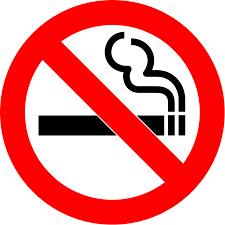Smoking is responsible for the deaths of 443 thousand people per year, but still 42% of Americans participate in the dangerous habit.
 These people do not smoke each cigarette to fulfill a death wish, but are simply addicted to Nicotine, a liquid in cigarettes that disables the action of autonomic nerve and skeletal muscle cells if used in large amounts.
These people do not smoke each cigarette to fulfill a death wish, but are simply addicted to Nicotine, a liquid in cigarettes that disables the action of autonomic nerve and skeletal muscle cells if used in large amounts.
Nicotine, in fact, is known for being highly addictive. Only a low percentage (around 20%) of all smokers are able to quit. However, due to education on the dangers of smoking, less Americans choose to begin to smoke.
Most people already know how smoking can affect your lungs, but what about the rest of the body?
Central Nervous System
Smoking can affect eyesight by increasing macular degeneration (an incurable eye disease that causes vision loss) and Cataracts. The sense of smell and taste are weakened due to the menthol contained in most cigarettes.
Integumentary System
Skin discoloration and premature wrinkles are another affect of smoking. Stains on teeth (brown and yellow) and fingers (yellow) are the results of residue left behind by the cigarette smoke. The smoke also leaves behind a scent that causes your hair to smell.
 Unhealthy and Healthy Lungs
Unhealthy and Healthy Lungs
Respiratory System
Smokers have a higher risk of infection, cold, and flu. They are also more likely to develop Chronic Obstructive Pulmonary Disease (COPD), lung cancer, Emphysema, and Bronchitis.
Cardiovascular System
Smoking causes the blood vessels to tighten, which restricts the flow of blood. Good cholesterol levels are lowered, but bad (LDL) cholesterol levels raise which can cause blood clots. Blood pressure begins to increase which results in the stretching of arteries. Smoking also can increase one’s risk for blood cancer.
Reproductive System
Smoking can prevent men from getting an erection. It can also result in high infertility and start menopause early.
Second Hand Smoke
Second Hand Smoke is worse than, if not just as bad as, actually smoking. It results in 34000 deaths per year from heart disease, 7300 deaths per year of lung cancer and it too damages the lining of blood vessels.
Children who are exposed to second hand smoke are more likely to have SIDS (Sudden Infant Death Syndrome), Bronchitis, Pneumonia, Asthma attacks, Ear infections, and Chronic Cough.
People who smoke or are exposed to second-hand smoke while pregnant are more likely to have a premature delivery.
As stated before only around 20% of smokers are able to quit smoking. Still, through proper guidance these numbers can increase.
American Lung Association
One of the goals of this organization is to eliminate tobacco and diseases caused by or related to tobacco use. They are responsible for the Smokefree Air Challenge: a call for all states to ban smoking in public areas (bars, restaurants), which can reduce diseases and deaths caused by second hand smoke. Freedom From Smoking are a series of smoking cessation classes that are apart of the American Lung Association’s anti-smoking program which helps participants learn to avoid their triggers and successfully stop smoking. To become more involved in the American Lung Association’s mission, join your local Lung Action Network, an organization that meets with legislators to promote anti-smoking laws and to receive monthly newsletters.
Ways to Quit
 The most common rout taken to quit smoking is Cold Turkey (you simply choose not to smoke. But this only works for 4% to 7% of people. When one uses behavioral therapy they usually work with a therapist to find a plan to avoid your triggers. Nicotine Replacement Therapy usually tries for you to find a temporary nicotine substitute: gum, patches, inhalers, sprays, lozenges, medicine (examples: Chantix and Zyban), etc. Combo Treatments is simply using more than one of these methods at once.
The most common rout taken to quit smoking is Cold Turkey (you simply choose not to smoke. But this only works for 4% to 7% of people. When one uses behavioral therapy they usually work with a therapist to find a plan to avoid your triggers. Nicotine Replacement Therapy usually tries for you to find a temporary nicotine substitute: gum, patches, inhalers, sprays, lozenges, medicine (examples: Chantix and Zyban), etc. Combo Treatments is simply using more than one of these methods at once.
A local resource to stop smoking is Smoking Cessation Classes at Health Department Classes and Curtis V Copper classes. They are an example of a type of behavioral therapy.
Smoking is nothing more than a deadly killer that slowly, but assuredly, destroys its victims. It is not impossible to save yourself once you start. Know and avoid your triggers, the first days after quitting are always the hardest, but with perseverance you can do it.
- Also, while supplies last, the Georgia Tobacco Quit Line is offering 4 weeks worth of nicotine replacement therapy (in the form of gum or patch), FREE of charge.
Call now! 1-877-270-STOP
-
Sources
-
Matini, Melinda. “Effects of Secondhand Smoke.” WebMD. WebMD, 12 Sept. 2014. Web. 26 June 2015
“Our Mission and Goals – American Lung Association.” American Lung Association. American Lung Association, n.d. Web. 26 June 2015
Pietrangelo, Ann. “The Effects of Smoking on the Body.” Healthline. Healthline Networks Inc, 25 Aug. 2014. Web. 26 June 2015.
Ratini, Melinda. “Ways to Quit Smoking: Cold Turkey, Nicotine Replacement Therapy, and More.” WebMD. WebMD, 16 Sept. 2014. Web. 26 June 2015

